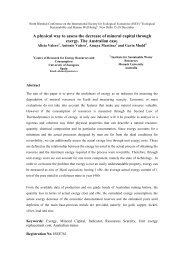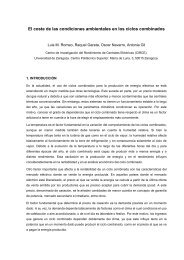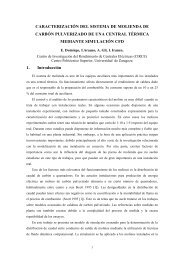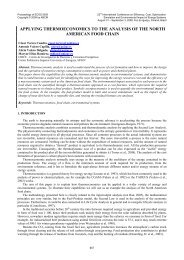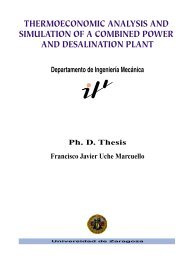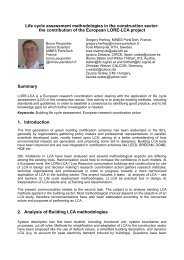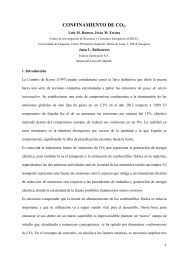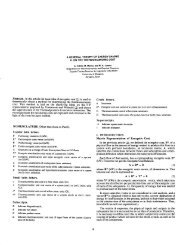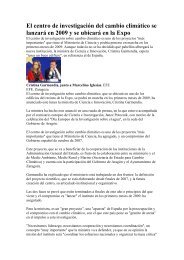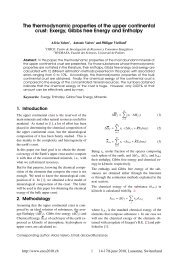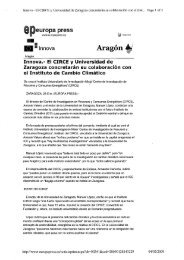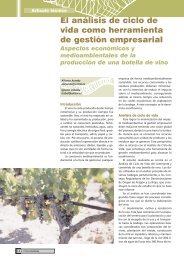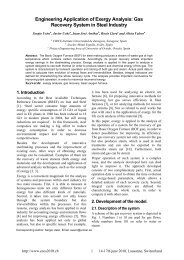CHARACTERIZATION OF A BIOMASS MILLING PILOT ... - circe
CHARACTERIZATION OF A BIOMASS MILLING PILOT ... - circe
CHARACTERIZATION OF A BIOMASS MILLING PILOT ... - circe
Create successful ePaper yourself
Turn your PDF publications into a flip-book with our unique Google optimized e-Paper software.
Belt conveyor<br />
B.1<br />
A.1.Configuration<br />
A.2 Configuration<br />
B.1 Configuration<br />
B.2 Configuration<br />
C Configuration<br />
Duplex mill<br />
C<br />
Coarse<br />
recirculation<br />
Hammer<br />
mill<br />
l<br />
Hammer<br />
mill<br />
l<br />
A.2<br />
Fig 1: Milling configurations of experimental pilot plant<br />
Comunication network: It is used to<br />
communicate the PLC with the others devices<br />
in the network. The industrial fielbus used in as<br />
plant are CANOpen and Ethernet.<br />
Supervisor Control And Data Acquisition<br />
(SCADA): It is the Human Machine Interface<br />
(HMI) and offers the function of monitoring<br />
and control the operation in the plant.<br />
Several control loops have been implemented to<br />
regulate and optimize the equipment electrical<br />
consumption. Used control loops are:<br />
Biomass feed rate control: this control loops<br />
optimize the mills electrical consumption<br />
regulating the biomass feed rate by means to<br />
control the feeding belt conveyor velocity. It<br />
exits an optimal input biomass feed rate for<br />
which milling energy requirement (kWh/t)<br />
decreases [12].<br />
Pneumatic conveying control. Control is carried<br />
out varying the angular speed of fans blades.<br />
By means of this control, the pressure at mill<br />
outlet can be modified to observe the influence<br />
in the particle residence time in grinding<br />
chamber (section 3.1.1).<br />
Finally, operational parameters should be obtained,<br />
registered and analyzed to study their influence in the<br />
process and in the milled product. A study of the<br />
instrumentation has been carried out to obtain these<br />
variables.<br />
3 OPERATIONAL PARAMETERS<br />
Pilot plant characterization requires the inherent<br />
processes identification during the milling to determinate<br />
the variables that have significant influence in the<br />
pulverized biomass properties or/and in the milling<br />
A.1<br />
B.2<br />
Cyclone<br />
+<br />
Screen<br />
classifier<br />
Biomass bin<br />
Bag filter<br />
Primary air<br />
Secondary air<br />
Screw feeder<br />
energy requirement.<br />
Two influential processes inside the milling chamber<br />
are analyzed:<br />
Residence time of the particles<br />
Drying effect during milling<br />
3.1 Residence time<br />
Describes the amount of time a particle could spend<br />
inside the grinding chamber. Consequently, the particle<br />
can be impacted and fractured by the mobile elements<br />
inside the mill.<br />
Usually, the final maximum particle size in the<br />
milling chamber is fixed by a metal screen that encloses<br />
the chamber, or by pneumatic system.<br />
The final goal consists in determining the optimal<br />
operational conditions for which the particle evacuates<br />
the chamber as far as possible when its size is smaller as<br />
desired size. Residence time increase involves higher<br />
possibility of new breaking actions which entails milling<br />
energy consumption increment in creating new particle<br />
surfaces. This over-consumption would not be necessary<br />
because the particle would have had a suitable size.<br />
Obviously, the screen openings sizes and mechanical<br />
properties of biomass are fundamental factors in<br />
connection with residence time. Others aspects with no<br />
direct dependency have been analyzed to check his<br />
influence on residence time.<br />
3.1.1 Mill outlet pressure<br />
Particle removal can be by gravity or pneumatic<br />
discharge. Gravity discharge takes place when other<br />
pneumatic system is not connected to mill outlet. The<br />
mill fan effect generates a slight overpressure in the<br />
outlet region. Rotating hammers in the grinding mill act<br />
as fan and built up air pressure against the screen and mill<br />
outlet.<br />
On the other side, pneumatic discharge is commonly



